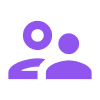When you’re an SMB organization going to purchase HR software to revamp your HR cycle, there are a number of things to consider. Before you can actually look for a new HR software vendor, it is important to properly identify the problems of the current software, or, for example, problems in your current interview cycle.
We give you the indispensable steps within the process so that you can choose the right software package or HR system that best suits the needs and requirements of the organization and the HR department. To do this, use the practical checklist Learned has created so you know at a glance what to look for when using software to revamp the HR cycle.
The preparation
Before you start looking for new HR software, it is important to first analyze how things are going now and what the ideal HR cycle is for your company.
To best identify the problems or shortcomings of the current cycle, we recommend that you simply engage in conversation with all parties involved. Gather input with, for example, a survey or an interactive session with the managers and employees involved.
1. Inventory the prerequisites for the new HR cycle software
Knowing the main challenges and shortcomings of the current interview cycle will help you translate them into key areas for improvement. You can also think of these areas of improvement as your goals for the new software. These preconditions provide clear direction and act as a guide in the search for a suitable software vendor. This process should be done properly and thoroughly; after all, it determines the foundation of HR processes for the entire organization.
For example, where will be the responsibility for system support? Is Software-as-a-Service the starting point or will the in-house IT department facilitate it? Are the goals the same for the entire company or do they vary by process or department? Once the points of the playing field are visible, it is time to draw the lines.
TIP: Even at this stage, get inspired by providers of the various modern HR software packages. After all, they see the HR Cycles of different companies on a daily basis and can help you with best practices at this preliminary stage!
Are you in the process of revamping your company’s HR cycle and could use some support in identifying current issues and designing a new interview cycle? Download our Eguide for designing a modern HR interview cycle.
2. Turn the requirements into a Program of Requirements
So the moment the preconditions are set, it is time to draw up a concrete Program of Requirements (PoR). The PoA contains a total overview of all the requirements the software must meet. This is an overview of the outcome: what should it do or be able to do. The more extensive and concrete this list is, the better the software will soon fit the organization and actually add value to HR processes.
By re-engaging with the (future) users of the software, you can make the translation from the current work and processes to the new software. You put the overview of recommendations and ideas from the organization next to the overview from the HR department and management. This gives you an overall view of preconditions, functional requirements, user requirements and design constraints. This forms the integral to content requirements for the new software to be purchased. From here, a distinction is made between the must-haves and the nice-to-haves.
3. The selection process for new HR software
With the PvE properly completed, it’s time for the topic that makes the HR department’s life a lot easier: assistive technology. This part of the search involves choosing about three different vendors that come closest to the stated needs and requirements. Creating a modern conversation cycle with continuous dialogue without technological support is virtually unthinkable. After all, Performance Management Software allows you to save time on administrative operations that you can invest in actually conducting a new appraisal cycle. Therefore, it is important to consider these 5 important factors while making a selection of software vendors:
1. Flexibility
Can the platform be set up to communicate and collaborate with other important tools and systems used in the business? By testing this in advance, you avoid having to make unnecessary and costly workarounds.
2. Onboarding and implementation
Is there a customer success manager available who can support the stakehold
3. Commissioning
After deploying the software, it always takes some time for everyone (employees, management and HR) to get used to the new platform or system. A good follow-up structure consists of frequent contact moments for further support and to achieve the set goals.
4. Usability
The success of HR software hinges on proper adoption by its users; the organization’s employees. The degree of user-friendliness is of great importance here.
5. Preconditions
When using a performance management system, you don’t want to have to think about the processing of privacy data according to AVG legislation or the security guaranteed through ISO certification. Therefore, these issues should be taken into account while selecting the right software vendor.
In addition to doing your own research, it is also very valuable to get advice from HR consulting firms. For example, on the website of Incomme (HR and salary experts) you will find a nice overview of all the features and benefits of Learned’s software.
Once a number of software vendors have been selected, it is time for the next step to make a final choice.
4. Here’s how to choose a definitive HR cycle software vendor
There are a large number of HR software vendors on the market and not all of them will be suitable to provide the new HR cycle system for your company.
Setting up several test cases helps to determine the extent to which the selected company can perform on the stated requirements with the software they provide.
A test case can be drawn up for each department or, for example, for each HR work area, forming a total of the most important HR processes. Importantly, it should at least give a good idea of the feasibility of the Program of Requirements.
By giving all selected software vendors the test case, mutual differences and advantages quickly stand out. Thus, this section is indispensable when selecting a final supplier.
Time to close the deal
After choosing a software vendor, contract negotiations come. It is important not to lose sight of the 5 tips from Step 3 in this final part of the search. After all, this is the time to make concrete agreements about, for example, providing support. Until how long after implementation is there full-time support or what is the service level for answering a question or resolving an issue within the system? And what are the arrangements around scaling up or down the number of users of the platform. Is this flexible or does this go per 10 users?
What is Learned?
Learned has been developing a performance management tool since 2018 that helps companies implement continuous dialogue. Unique to Learned’s perfomance management software are the development conversations. Using Artificial Intelligence, the Performance management system facilitates development conversations based on the employee’s relevant skills & competencies. This makes it easy for the manager to have quality development conversations with employees without taking extra time.
Watch the video demo or use the software free for 14 days to see how these unique development conversations can help your organization improve the HR cycle.


























